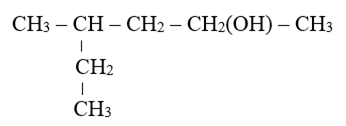 Multiple Choice Questions
Multiple Choice QuestionsWhat is 'X' in the following sequence ?
ArN2Cl Z Y X
Benzoic acid
Sodium benzoate
Benzaldehyde
Benzene
A salt on reacting with dil. H2S04 gives a reddish brown gas. The salt is:
KNO2
ZnBr2
NaNO3
FeCl3
The IUPAC name of the following compound is

2-ethylpentanol-4
3-methylhexanol-3
4-methylhexanol-2
4-ethylpentanol-2
Amongst the following, the compound that can most readily get sulphonated is :
benzene
toluene
nitrobenzene
chlorobenzene
(R)-2-Iodobutane is treated with NaI in acetone and allowed to stand for a long time. The product eventually formed is
(R)-2-iodobutane
(S)-2-iodobutane
(±)-2-iodobutane
(±)-1, 2-diiodobutane
Which ofthe following complexes exists as pair of enantiomers ?
trans-[Co(en)2Cl2]+
[Co(NH3)2Cl2]+
[Co{P(C2H5)3}2ClBr]
[Cr(en)3]3+
